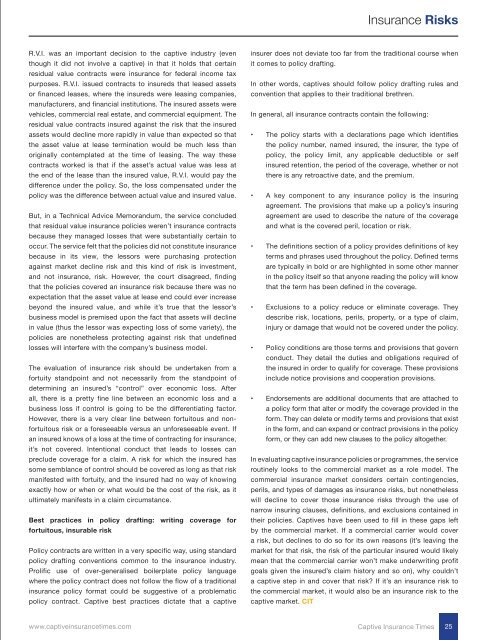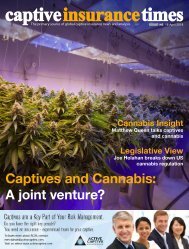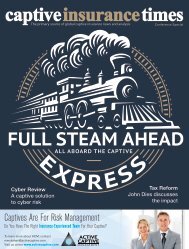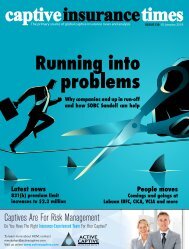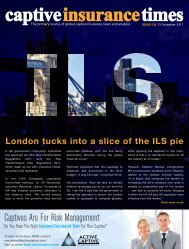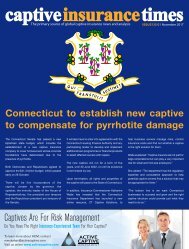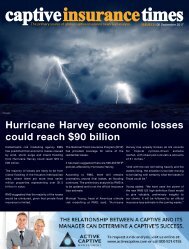Captive Insurance Times issue 136
Inside this issue of Captive Insurance Times, find out what industry experts predict the potential opportunities and challenges will be for the captive industry in 2018. Phillip Giles of QBE North America provides his thoughts on future opportunities for the healthcare sector. Also, history shows that it is difficult to predict when interest rates will change and when markets will rise or fall, which, according to Stephen Nedwicki of Comerica Bank, is even more reason to maintain a disciplined approach to your investments.
Inside this issue of Captive Insurance Times, find out what industry experts predict the potential opportunities and challenges will be for the captive industry in 2018.
Phillip Giles of QBE North America provides his thoughts on future opportunities for the healthcare sector.
Also, history shows that it is difficult to predict when interest rates will change and when markets will rise or fall, which, according to Stephen Nedwicki of Comerica Bank, is even more reason to maintain a disciplined approach to your investments.
Create successful ePaper yourself
Turn your PDF publications into a flip-book with our unique Google optimized e-Paper software.
<strong>Insurance</strong> Risks<br />
R.V.I. was an important decision to the captive industry (even<br />
though it did not involve a captive) in that it holds that certain<br />
residual value contracts were insurance for federal income tax<br />
purposes. R.V.I. <strong>issue</strong>d contracts to insureds that leased assets<br />
or financed leases, where the insureds were leasing companies,<br />
manufacturers, and financial institutions. The insured assets were<br />
vehicles, commercial real estate, and commercial equipment. The<br />
residual value contracts insured against the risk that the insured<br />
assets would decline more rapidly in value than expected so that<br />
the asset value at lease termination would be much less than<br />
originally contemplated at the time of leasing. The way these<br />
contracts worked is that if the asset’s actual value was less at<br />
the end of the lease than the insured value, R.V.I. would pay the<br />
difference under the policy. So, the loss compensated under the<br />
policy was the difference between actual value and insured value.<br />
But, in a Technical Advice Memorandum, the service concluded<br />
that residual value insurance policies weren’t insurance contracts<br />
because they managed losses that were substantially certain to<br />
occur. The service felt that the policies did not constitute insurance<br />
because in its view, the lessors were purchasing protection<br />
against market decline risk and this kind of risk is investment,<br />
and not insurance, risk. However, the court disagreed, finding<br />
that the policies covered an insurance risk because there was no<br />
expectation that the asset value at lease end could ever increase<br />
beyond the insured value, and while it’s true that the lessor’s<br />
business model is premised upon the fact that assets will decline<br />
in value (thus the lessor was expecting loss of some variety), the<br />
policies are nonetheless protecting against risk that undefined<br />
losses will interfere with the company’s business model.<br />
The evaluation of insurance risk should be undertaken from a<br />
fortuity standpoint and not necessarily from the standpoint of<br />
determining an insured’s “control” over economic loss. After<br />
all, there is a pretty fine line between an economic loss and a<br />
business loss if control is going to be the differentiating factor.<br />
However, there is a very clear line between fortuitous and nonfortuitous<br />
risk or a foreseeable versus an unforeseeable event. If<br />
an insured knows of a loss at the time of contracting for insurance,<br />
it’s not covered. Intentional conduct that leads to losses can<br />
preclude coverage for a claim. A risk for which the insured has<br />
some semblance of control should be covered as long as that risk<br />
manifested with fortuity, and the insured had no way of knowing<br />
exactly how or when or what would be the cost of the risk, as it<br />
ultimately manifests in a claim circumstance.<br />
Best practices in policy drafting: writing coverage for<br />
fortuitous, insurable risk<br />
Policy contracts are written in a very specific way, using standard<br />
policy drafting conventions common to the insurance industry.<br />
Prolific use of over-generalised boilerplate policy language<br />
where the policy contract does not follow the flow of a traditional<br />
insurance policy format could be suggestive of a problematic<br />
policy contract. <strong>Captive</strong> best practices dictate that a captive<br />
insurer does not deviate too far from the traditional course when<br />
it comes to policy drafting.<br />
In other words, captives should follow policy drafting rules and<br />
convention that applies to their traditional brethren.<br />
In general, all insurance contracts contain the following:<br />
• The policy starts with a declarations page which identifies<br />
the policy number, named insured, the insurer, the type of<br />
policy, the policy limit, any applicable deductible or self<br />
insured retention, the period of the coverage, whether or not<br />
there is any retroactive date, and the premium.<br />
• A key component to any insurance policy is the insuring<br />
agreement. The provisions that make up a policy’s insuring<br />
agreement are used to describe the nature of the coverage<br />
and what is the covered peril, location or risk.<br />
• The definitions section of a policy provides definitions of key<br />
terms and phrases used throughout the policy. Defined terms<br />
are typically in bold or are highlighted in some other manner<br />
in the policy itself so that anyone reading the policy will know<br />
that the term has been defined in the coverage.<br />
• Exclusions to a policy reduce or eliminate coverage. They<br />
describe risk, locations, perils, property, or a type of claim,<br />
injury or damage that would not be covered under the policy.<br />
• Policy conditions are those terms and provisions that govern<br />
conduct. They detail the duties and obligations required of<br />
the insured in order to qualify for coverage. These provisions<br />
include notice provisions and cooperation provisions.<br />
• Endorsements are additional documents that are attached to<br />
a policy form that alter or modify the coverage provided in the<br />
form. They can delete or modify terms and provisions that exist<br />
in the form, and can expand or contract provisions in the policy<br />
form, or they can add new clauses to the policy altogether.<br />
In evaluating captive insurance policies or programmes, the service<br />
routinely looks to the commercial market as a role model. The<br />
commercial insurance market considers certain contingencies,<br />
perils, and types of damages as insurance risks, but nonetheless<br />
will decline to cover those insurance risks through the use of<br />
narrow insuring clauses, definitions, and exclusions contained in<br />
their policies. <strong>Captive</strong>s have been used to fill in these gaps left<br />
by the commercial market. If a commercial carrier would cover<br />
a risk, but declines to do so for its own reasons (it’s leaving the<br />
market for that risk, the risk of the particular insured would likely<br />
mean that the commercial carrier won’t make underwriting profit<br />
goals given the insured’s claim history and so on), why couldn’t<br />
a captive step in and cover that risk? If it’s an insurance risk to<br />
the commercial market, it would also be an insurance risk to the<br />
captive market. CIT<br />
www.captiveinsurancetimes.com<br />
<strong>Captive</strong> <strong>Insurance</strong> <strong>Times</strong><br />
25


